Easy Wildflowers
Plant list from Easy Native Wildflowers for your Home Landscape by Catherine Bollinger. 2020/21 Fall/Winter Conservation Gardener Magazine| Scientific/Common Name | Family | Duration & Habit | Flower Color | Bloom Time | Height | Exposure | Moisture | Germination Code | Comments | Thumb |
| Asarum canadense Wild Ginger |
Aristolochiaceae Birthwort Family |
Perennial
Herb |
Red, Green, Purple, Brown | Mar, Apr, May, Jun | 2–8 in. | Part Shade, Shade | Dry, Average, Moist | Wild ginger is an excellent spreading groundcover. The newly emerging deciduous leaves in early spring are a welcome change in the landscape. The small bell-shaped maroon flowers are at ground level, under the leaves. Wide heart-shaped leaves are attractive throughout the growing season. Easy to grow, and works well interplanted with other woodland species. The Cherokee Indians had many medicinal uses for this native plant. When the root is cooked with sugar, it can be used as a substitute for ginger. |
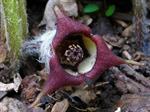 |
|
| Chrysogonum virginianum Green-and-gold |
Asteraceae Aster Family |
Perennial
Herb |
Yellow | Mar, Apr, May, Jun, Jul, Aug, Sep, Oct | 2-10 in. | Part Shade | Moist | 2 | Green-and-gold makes a nice semi-evergreen groundcover or edging for a path. Good drainage is essential for this southeastern native perennial. If grown on a slope or with a gravel mulch, you may well find seedlings near the parent plant. Green-and-gold is a versatile long-bloomer so you are sure to enjoy it in your garden. Try applying a thin pea-gravelmulch around your plants to encourage them to produce seedlings. |
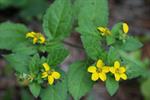 |
| Coreopsis verticillata Whorled Tickseed |
Asteraceae Aster Family |
Perennial
Herb |
Yellow | Apr, May, Jun, Jul, Aug | 2-3 ft. | Sun, Part Shade | Dry, Average, Well-drained | The dainty yellow flowers of whorled tickseed bloom for a number of weeks beginning in early summer. Though the flowers and fine-textured foliage are delicate in appearance, this easy-to-grow southeastern native perennial is virtually free of garden pests. Whorled tickseed is a good choice for your perennial border or naturalized meadow. Each plant grows into a handsome clump. When in bloom, it is very attractive to butterflies. |
 |
|
| Echinacea purpurea Eastern Purple Coneflower |
Asteraceae Aster Family |
Perennial
Herb |
Pink, Purple | Apr, May, Jun, Jul, Aug, Sep, Oct, Nov | 1.5-4 ft. | Sun, Part Shade, Shade | Dry, Average | A gardener’s favorite, eastern purple coneflower is an excellent choice for the sunny border or meadow garden. The showy flowers have pink petals around a central "cone". Drought-tolerant once established. All parts of this plant are regarded to have properties that stimulate the immune system. Butterflies flock to the flowers for their nectar and goldfinches eat the seeds with gusto. Eastern purple coneflower is a plant that will liven up your garden in many ways! |
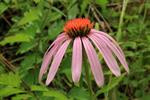 |
|
| Eupatorium perfoliatum Boneset |
Asteraceae Aster Family |
Perennial
Herb |
White | Jun, Jul, Aug, Sep, Oct, Nov | 3-4 ft. | Sun, Part Shade | Average, Moist | Boneset is an attractive, easily grown southeastern native perennial. Small creamy white flowers are borne in abundance in late summer. It is an excellent plant to include in butterfly gardens. The handsomely textured leaves of this plant are attractive throughout the growing season. Native Americans used boneset, also known as feverwort, medicinally for a variety of ailments. The Eupatorium genus supports up to 40 lepidoptera species. |
 |
|
| Eurybia divaricata White Wood Aster |
Asteraceae Aster Family |
Perennial
Herb |
White, Yellow, Brown | Jul, Aug, Sep, Oct, Nov | 1-2 ft. | Sun, Part Shade, Shade | Dry, Average, Moist | 2 | White wood aster is one of the few asters that tolerates shade. Its starry white flowers are welcome in dark spots. Once established, this species typically blooms for many weeks. This southeastern native perennial is stoloniferous and can be counted on to make a dark green groundcover over time. Plants perform best in dappled shade and average soil. |
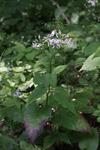 |
| Helenium flexuosum Purplehead Sneezeweed |
Asteraceae Aster Family |
Perennial
Herb |
Yellow | Apr, May, Jun, Jul, Aug, Sep | 1-3 ft. | Sun, Part Shade, Shade | Dry, Average, Moist | This handsome SE native produces multibranched stems of bright yellow flowers, each with a prominent dark purplish center. While this plant does not cause hay fever symptoms, it is also known as sneezeweed because it blooms at the same time as ragweed. Often found growing around the edges of ponds and on streambanks, it also does well in average soil conditions. This perennial is deer resistant and makes a wonderful cut flower. This species is being studied for its anticancer properties. |
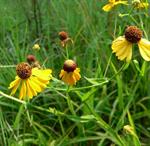 |
|
| Helianthus angustifolius Swamp Sunflower |
Asteraceae Aster Family |
Perennial
Herb |
Yellow, Purple, Brown | Aug, Sep, Oct, Nov | 1-6 ft. | Sun, Part Shade, Shade | Average, Moist | 2 | Easy to grow and extremely showy, swamp sunflower produces upright stems of buttery yellow flowers with dark centers, each flower 2 to 3 inches across. Plant it where it has room to reach its full-grown stature. Swamp sunflower makes a fine cut flower. Butterflies flock to it as a source of nectar, and birds enjoy eating its seeds. Swamp sunflower is seen growing in savannahs and wet meadows, primarily in the coastal plain and lower Piedmont. The Helianthus genus supports up to 73 lepidoptera species. 2007 N.C. Wildflower of the Year. |
 |
| Hibiscus moscheutos Crimson-eyed Rose-mallow |
Malvaceae Mallow Family |
Annual, Perennial
Herb, Subshrub |
White, Pink | May, Jun, Jul, Aug, Sep, Oct | 4-6 ft. | Sun, Part Shade | Average, Moist | 3 | The blooms of crimson-eyed rose-mallow are among the largest of any of our native perennials. This shrubby perennial has plump, conspicuous flower buds - marvels of architecture and design in their own right which cluster at the tip of each stem and open several at a time. Crimson-eyed rose-mallow normally grows in wet areas such as in marshes and along shorelines, though this perennial also thrives in garden soils with average moisture. 1997 N.C. Wildflower of the Year |
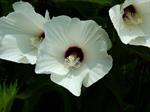 |
| Liatris spicata Sessile Blazing-star |
Asteraceae Aster Family |
Perennial
Herb |
Pink, Purple | Jul, Aug, Sep | 1-4 ft. | Sun | Average | Butterflies love Sessile Blazing-star as much as people do. Its showy spikes of purple flowers bloom in midsummer. Full sun is ideal. Sessile Blazing-star is native to coastal savannas and bogs. It thrives in average soil. This southeastern native perennial can easily be grown in a perennial border or as part of a naturalized meadow.The Cherokee tribe used this species for a variety of medicinal purposes. |
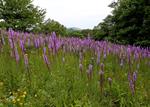 |
|
| Lobelia siphilitica Great Blue Lobelia |
Campanulaceae Bellflower Family |
Perennial
Herb |
Blue | Jul, Aug, Sep, Oct | 1.5-4 ft. | Sun, Part Shade | Average | 1,4 | Spikes of lovely blue flowers rise above sturdy plants in late summer. In the wild, great blue lobelia is frequently seen growing in wet meadows and low areas. This adaptable southeastern native perennial will thrive in your perennial border. The blue flowers add a welcome "cool" touch in the summer garden. This perennial is also attractive to butterflies and hummingbirds. Used medicinally by Native Americans. 1993 N.C Wildflower of the Year |
 |
| Maianthemum racemosum Solomon’s-plume |
Ruscaceae Ruscus Family |
Perennial
Herb |
White | Apr, May, Jun | 10-24 in. | Shade | Moist | Solomon’s-plume features clusters of tiny white flowers blooming at the ends of its arching stems in late spring. Its flowers are followed by showy reddish fruits in late summer that provide a nice contrast with the glossy green foliage. Solomon’s-plume is an excellent plant for your shade garden. Although this shade-loving native perennial is not often offered for sale, it is easy to grow in moist soil with lots of organic matter. You can plant it in combination with Wild Ginger to enhance your woodland garden. |
 |
|
| Monarda didyma Beebalm |
Lamiaceae Mint Family |
Perennial
Herb |
Red | May, Jun, Jul, Aug, Sep, Oct | 2-4 ft. | Sun, Part Shade, Shade | Dry, Average, Moist | 1 | Beebalm has clusters of showy tubular red flowers that are truly spectacular when it is in full bloom. Hummingbirds seek out the colorful flowers of this plant for their nectar. The foliage of this easily grown plant is aromatic when crushed. Beebalm naturally occurs in wet areas and alongside streams, though it is equally happy in average growing conditions. Beebalm, like most members of the mint family, tends to spread. |
 |
| Monarda fistulosa Wild Bergamot |
Lamiaceae Mint Family |
Perennial
Herb |
White, Pink, Purple | May, Jun, Jul, Aug, Sep | 2-5 ft. | Sun, Part Shade | Dry, Average, Moist | 1, 4 | Like several other Monarda species, M. fistulosa makes an excellent cut flower. This plant is also a great addition to any pollinator garden because it attracts birds, hummingbirds and butterflies. The plant is also highly deer resistant. In the wild this plant is found growing in dry open woods, fields, wet meadows and ditches. M. fistulosa will grow in a variety of soil conditions but is not tolerant of flooding. |
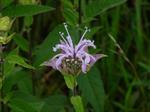 |
| Oenothera fruticosa Southern Sundrops |
Onagraceae Evening-primrose Family |
Perennial
Herb |
Yellow | Mar, Apr, May, Jun, Jul, Aug, Sep | 1-2 ft. | Sun, Part Shade, Shade | Dry, Average | 1, 4 | The lemon-yellow flowers of southern sundrops add a cheerful touch to the garden. They make a nice low-growing filler for the sunny perennial border. The attractive foliage is glossy green, often with purplish spots. In the wild, southern sundrops are found growing in dry woods and meadows and along roadsides. Any well-drained soil is fine for growing this cheerful southeastern native perennial. Very drought-tolerant once established. The Oenothera genus supports up to 16 species of lepidoptera. 1989 N.C. Wildflower of the Year. |
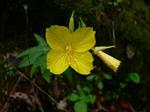 |
| Packera aurea Golden Ragwort |
Asteraceae Aster Family |
Perennial
Herb |
Yellow | Mar, Apr, May, Jun, Jul, Aug | 1-2 ft. | Sun, Part Shade, Shade | Average, Moist | 2 | Golden ragwort has flattened terminal clusters of golden yellow flower heads that brighten the springtime garden. This easily grown perennial combines nicely with eastern columbine or eastern blue phlox. Its rosettes of deep green leaves persist through most of the year. Evenly moist soil is ideal for this southeastern native perennial, but it will also thrive in average soil. Plants will spread readily from creeping roots and self-sown seedlings. |
 |
| Phlox divaricata Eastern Blue Phlox |
Polemoniaceae Jacob's-ladder Family |
Perennial
Herb |
White, Blue, Purple | Mar, Apr, May, Jun | to 20 in. | Part Shade, Shade | Dry, Average | This early-flowering SE native is an excellent garden plant. Its panicles of fragrant pale blue to white flowers are plentiful in the spring and make great cut flowers. Eastern blue phlox is semi- evergreen and makes a fine edging or woodland groundcover. Often found growing in rich woods, this phlox self- sows to create impressive drifts. Try planting in combination with eastern columbine for a beautiful spring garden. |
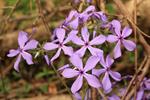 |
|
| Phlox glaberrima Smooth Phlox |
Polemoniaceae Jacob's-ladder Family |
Perennial
Herb |
Red, Pink, Purple | Mar, Apr, May, Jun, Jul | 2-4 ft. | Sun, Part Shade, Shade | Dry, Average, Moist | This southeastern native phlox is vigorous and showy, producing panicles of bright pink flowers that appear just as the blooms of Phlox divaricata have faded. Cut this species back following flowering to encourage repeat blooming. Overtime smooth phlox spreads to forms sizeable clusters. In the wild, this species is found growing in wet meadows and prairies and in open woodlands. Smooth phlox tolerates more soil moisture than most Phlox species. Mulch around the plant in the summer to increase soil moisture retention and to help keep the root zone cool. |
 |
|
| Phlox paniculata Summer Phlox |
Polemoniaceae Jacob's-ladder Family |
Perennial
Herb |
White, Red, Pink, Purple | Jun, Jul, Aug, Sep | 1-5 ft. | Sun, Part Shade, Shade | Dry, Average, Moist | Summer phlox blooms in late summer with panicles of beautiful pink flowers over a number of weeks. Their flower color ranges from bright pink to pale pink on different plants. This is an excellent perennial for attracting hummingbirds and butterflies. Summer Phlox grows in fertile bottomlands and meadows. It also thrives in average to moist soil in sunny gardens. Try this southeastern native perennial for some late-summer color. It makes a good cut flower too. |
 |
|
| Physostegia virginiana Obedient Plant |
Lamiaceae Mint Family |
Perennial
Herb |
Pink, Lavender, Purple | Jul, Aug, Sep, Oct | 3-4 ft. | Sun, Part Shade | Average, Moist | Obedient-plant grows easily with little care and tolerates most growing conditions. Its one-inch-long lavender flowers are clustered on upright spikes and are often visited by hummingbirds. Obedient-plant is commonly found growing in bogs and pine savannahs of the eastern United States. This southeastern native perennial thrives in soil of average moisture, too. Because of its colonizing root system, Obedient-plant tends to spread rapidly. Either plant it in a location where it can spread, or dig out any unwanted runners every year or so. |
 |
|
| Polemonium reptans Spreading Jacobs ladder |
Polemoniaceae Jacob's-ladder Family |
Perennial
Herb, Subshrub |
Blue, Purple | Apr, May, Jun | 6-18 in. | Part Shade, Shade | Moist, Well-drained | Spreading Jacobs-ladder has dainty bell- shaped pale blue flowers that arch over its graceful clumps of fern-like foliage. Its leaflets are arranged along the stems like the rungs of a ladder, hence its common name of Jacob's-ladder. The foliage of this choice southeastern native perennial looks good throughout the growing season. Try planting it with Appalachian Smooth Phlox for a delightful combination of pink and blue flowers. |
 |
|
| Polygonatum biflorum Solomons-seal |
Ruscaceae Ruscus Family |
Perennial
Herb |
White, Yellow | Apr, May, Jun | 1-3 ft. | Part Shade, Shade | Moist, Well-drained | Solomon’s-seal is a choice southeastern native perennial. Its pairs of greenish-white bell shaped pendant flowers are very attractive when the plant is in bloom. Deep blue berries follow the flowers. Plant this species in moist, well-drained humusy soil to keep the foliage looking its best through the growing season. Plants in the Polygonatum genus have a history of use both for food and as medicine, by the Cherokee as well as by other Native American tribes. |
 |
|
| Rudbeckia laciniata Green-head Coneflower |
Asteraceae Aster Family |
Perennial
Herb, Subshrub |
Yellow | Jul, Aug, Sep, Oct | 3-7 ft. | Sun, Part Shade | Average, Moist | 2 | Green-head coneflower is closely related to the black-eyed-susan, and bears dozens of 2-3 inch clear yellow flowers. Its graceful pendulous petals radiate from a gumdrop shaped greenish-yellow central disk. This southeastern native perennial is commonly found growing in wet areas. Green-head coneflower is very adaptable and will also thrive under the conditions in the average garden. 1995 N.C. Wildflower of the Year. |
 |
| Rudbeckia triloba Browneyed Susan |
Asteraceae Aster Family |
Perennial
Herb |
Yellow | Jun, Jul, Aug, Sep, Oct | 1-3 ft. | Sun, Part Shade | Average | The Brown-eyed-Susan produces many small showy flowers. This SE native perennial has an open “see-through†habit that is very charming in the garden. This species is easy to grow and blooms for a long time thriving in the average garden. If its seed heads are left, it is likely to reseed. Although it is not often offered for sale, the Brown-eyed-Susan is a charming wildflower. Try it in your garden - both you and the butterflies will love it! |
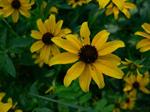 |
|
| Sanguinaria canadensis Bloodroot |
Papaveraceae Poppy Family |
Perennial
Herb |
White | Feb, Mar, Apr, May | 6-12 in. | Part Shade, Shade | Dry, Average, Moist | In early spring, bloodroot, a member of the poppy family, produces short-lived, snow-white flowers that open during the day and close at night. Unlike many other spring bloomers, the deeply-lobed blue-green foliage of this perennial persist in the landscape until mid- to late summer. Narrow upright seed pods hold ant dispersed seeds. Under optimal conditions this species will spread to form sizeable patches. The red sap found in the underground stems of bloodroot was used by Native Americans as a dye for baskets and clothing. |
 |
|
| Scutellaria incana Hoary Skullcap |
Lamiaceae Mint Family |
Perennial
Herb |
Blue, Purple, Violet | Jun, Jul, Aug, Sep | 1-4 ft. | Sun, Part Shade, Shade | Dry, Average, Moist, Well-drained | 3 then 2 | Hoary Skullcap has dense spikes of showy, deep blue flowers that bloom for many weeks in late summer. Its handsomely textured foliage contrasts beautifully with its unusual flowers. Its odd common name comes from the resemblance of the calyx of each flower to a skullcap. This SE native perennial typically grows in the mountains of North Carolina in open woods and clearings and along roadsides. It is attractive enough to make the transition to a more formal garden.  North Carolina Wildflower of the Year 2014 |
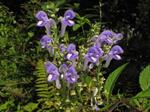 |
| Solidago caesia Axillary Goldenrod |
Asteraceae Aster Family |
Perennial
Herb |
Yellow | Aug, Sep, Oct | 1-3 ft. | Part Shade, Shade | Average | 2 | Unlike most of our goldenrods, axillary goldenrod thrives without full sun. This is one of very few perennials that will add some late season color to a shady garden. With graceful, arched stems and a clumping habit, this well behaved perennial makes a great garden plant. Tolerant of lean soils and shade it is a good tucked into a corner of the yard providing nectar for pollinators and brightening the view. The genus Solidago supports up to 112 lepidoptera species. |
 |
| Solidago odora Anise-scented Goldenrod |
Asteraceae Aster Family |
Perennial
Herb |
Yellow | Jun, Jul, Aug, Sep, Oct, Nov | 2-3 ft. | Sun, Part Shade, Shade | Dry, Average | 2 | Anise-scented goldenrod produces small plumes of bright yellow flowers that are a fine source of nectar for butterflies. The foliage of this perennial has an anise-like fragrance when it is crushed. Its compact size makes it a good choice for smaller gardens. People mistakenly believe that goldenrods cause allergies. Not so, their pollen is not wind-borne! Ragweed is the real culprit. The Cherokee made tea from its leaves and roots to treat various maladies. The genus Solidago supports up to 112 lepidoptera species. |
 |
| Stokesia laevis Stokes’ Aster |
Asteraceae Aster Family |
Perennial
Herb |
White, Blue, Purple | May, Jun, Jul, Aug, Sep | 1-2 ft. | Sun, Part Shade | Average, Moist, Well-drained | 2 | Elegant pale blue to purple flowers provide a striking show in the garden. Its notched ray petals surround a central disc containing many small flowers in the center. The color blue is uncommon and highly prized in the perennial border, complementing many other colors. The flowers are very attractive to butterflies. It is an excellent choice for the sunny perennial border. |
 |
| Symphyotrichum grandiflorum Large-flower American-aster |
Asteraceae Aster Family |
Perennial
Herb |
Red, Purple | Sep, Oct, Nov, Dec | 2-3 ft. | Sun, Part Shade, Shade | Dry, Average, Well-drained | 1 | This SE native perennial is one of the last asters to bloom in the fall. It bears many flower heads in panicles, with yellow central disc flowers surrounded by lavender-blue rays. Large-flower American-aster is a fine late-season nectar source for butterflies. This perennial can tolerate sunny lean sites once it is established. Large-flower American-aster is found at the edges of woods and in old fields of the piedmont and coastal plain. Its native range is from Virginia to South Carolina. |
 |
| Symphyotrichum laeve Smooth Blue Aster |
Asteraceae Aster Family |
Perennial
Herb |
Blue, Purple | Aug, Sep, Oct | 2-4 ft. | Sun | Dry, Average | Smooth Blue American-aster brings rich color to the garden in the fall and has small, but brilliant, purple flowers with yellow centers on loose, tall stems. The bluish-green leaves of this aster are smooth to the touch and slightly glossy. Virtually pest-free, this beautiful native perennial will attract a variety of butterflies and bees to your fall garden. |
 |
|
| Tiarella cordifolia Foamflower |
Saxifragaceae Saxifrage Family |
Perennial
Herb |
White, Pink | Mar, Apr, May, Jun, Jul | 10-12 in. | Part Shade, Shade | Dry, Average, Moist | This perennial grows in rich wooded areas of the mountains and piedmont, spreading by runners to form small colonies. Its leaves are similar to those of the red maple and have hairs on the upper surface. Foamflower blooms April through June, producing a six-inch stalk topped by delicate white flowers. Because the stamens protrude beyond the petals, the flower resembles a crown or “little tiaraâ€, as the Greek word tiarella describes. |
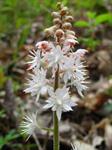 |
|
| Uvularia grandiflora Large-flower Bellwort |
Colchicaceae Meadow-saffron Family |
Perennial
Herb |
Yellow | Apr, May, Jun | 8-24 in. | Part Shade, Shade | Dry, Average |
 |
||
| Vernonia angustifolia Carolina Sandhill Ironweed |
Asteraceae Aster Family |
Perennial
Herb |
Purple | Jun, Jul, Aug, Sep | 2-4 ft. |
 |